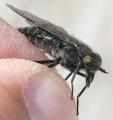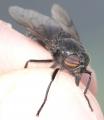Diptera.info :: Identification queries :: Diptera (adults)
Who is here? 1 guest(s)
|
Chironomidae? Or Ceratopogonidae? And more...
|
|
| Sundew |
Posted on 06-02-2008 23:37
|
|
Member Location: Berlin and Baden-Württemberg, Germany Posts: 3917 Joined: 28.07.07 |
Hello, These tiny black midges are obviously pollinators of Echinocystis lobata (Cucurbitaceae). Is Chironomidae the right family for them? Certainly we can't get closer to a name... (Again Island of Usedom in August.) Thanks, Sundew Sundew attached the following image: 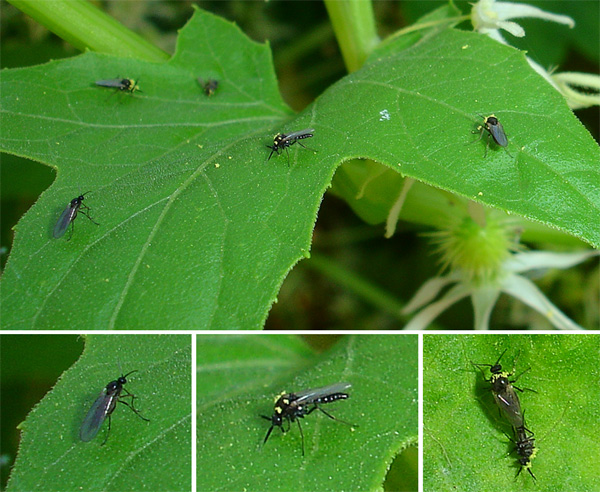 [160.04Kb] Edited by Sundew on 08-02-2008 22:36 |
|
|
|
| Jan Willem |
Posted on 07-02-2008 08:05
|
|
Member Location: Waalwijk, The Netherlands Posts: 2158 Joined: 24.07.04 |
Looks more like Ceratopogonidae to me, but I'm not certain at all about it. Jan Willem van Zuijlen |
|
|
|
| Xespok |
Posted on 07-02-2008 08:54
|
|
Member Location: Debrecen, Hungary Posts: 5551 Joined: 02.03.05 |
I agree with Jan. Certainly not Chironomids.
Gabor Keresztes Japan Wildlife Gallery Carpathian Basin Wildlife Gallery |
| Tony Irwin |
Posted on 08-02-2008 19:25
|
|
Member Location: Norwich, England Posts: 7286 Joined: 19.11.04 |
Yes, they are ceratopogonids - actually the pollen on the thorax is a give-away (though the folded plumes of the antennae is also a clue) - many ceratopogonids feed from flowers, wheras chironomids feed on honeydew if at all.
Tony ---------- Tony Irwin |
|
|
|
| Sundew |
Posted on 08-02-2008 22:30
|
|
Member Location: Berlin and Baden-Württemberg, Germany Posts: 3917 Joined: 28.07.07 |
Though this was straight from the horse's mouth, dear Tony, I'd like to add some pics and facts. This flowering Prickly Cucumber obviously attracts small midges and mosquitoes more than bigger flies or Hymenoptera. (Eristalis intricaria and a Sphecodes species were the only bigger visitors I saw.) It was noticeable that the small flies died in numbers, their bodies lay on every leaf. Beside Dilophus febrilis (Bibionidae) and the now identified ceratopogonids, many culicids of both sexes fed on the flowers, and several ceratopogonids were present as well. The small green ones were more frequent than the bigger brownish ones, and they did not only rest on and below the leaves but worked in the flowers. There were no aphids on the plant, so honeydew could not be the attractant. I must confess I do not know whether the unisexual flowers of Echinocystis produce nectar or possibly oil (like other taxa of the family), but these small flies are certainly no pollen-eaters and so fond of the flowers; so there must be some award. Something that even Chironomidae like! Sundew The first pic shows the visitor spectrum. Sundew attached the following image: 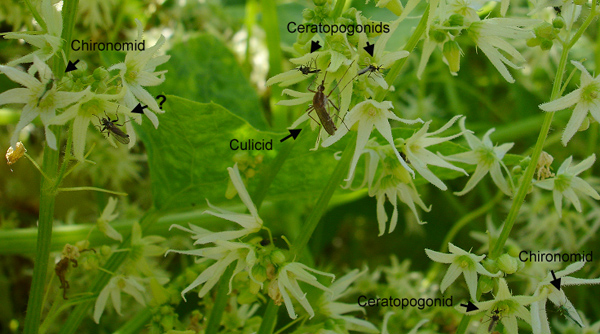 [166.79Kb] |
|
|
|
| Sundew |
Posted on 08-02-2008 22:32
|
|
Member Location: Berlin and Baden-Württemberg, Germany Posts: 3917 Joined: 28.07.07 |
The next pics show the chironomids a bit closer.
Sundew attached the following image: 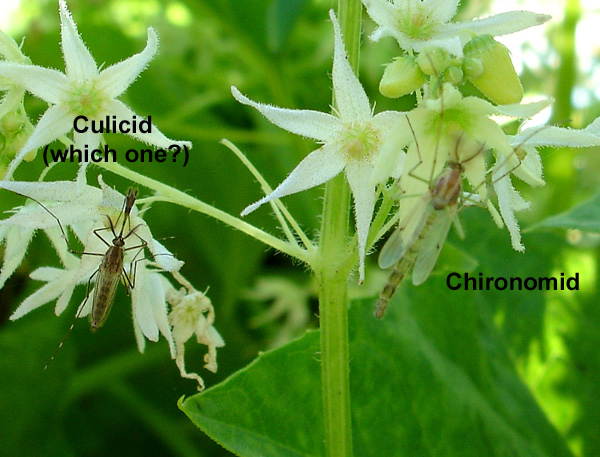 [170.2Kb] |
|
|
|
| Sundew |
Posted on 08-02-2008 22:33
|
|
Member Location: Berlin and Baden-Württemberg, Germany Posts: 3917 Joined: 28.07.07 |
Next one.
Sundew attached the following image: 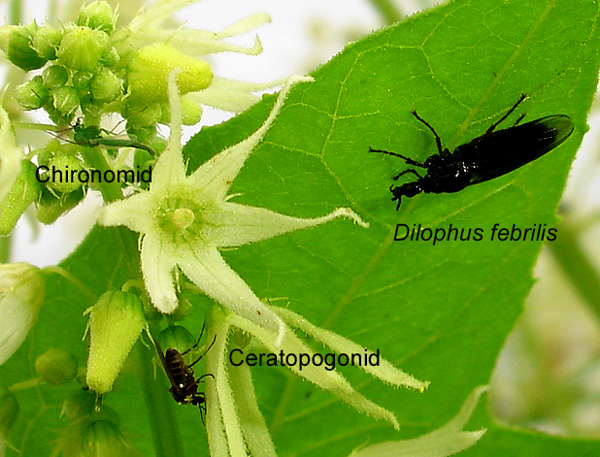 [149.29Kb] |
|
|
|
| Sundew |
Posted on 08-02-2008 22:34
|
|
Member Location: Berlin and Baden-Württemberg, Germany Posts: 3917 Joined: 28.07.07 |
Last one.
Sundew attached the following image: 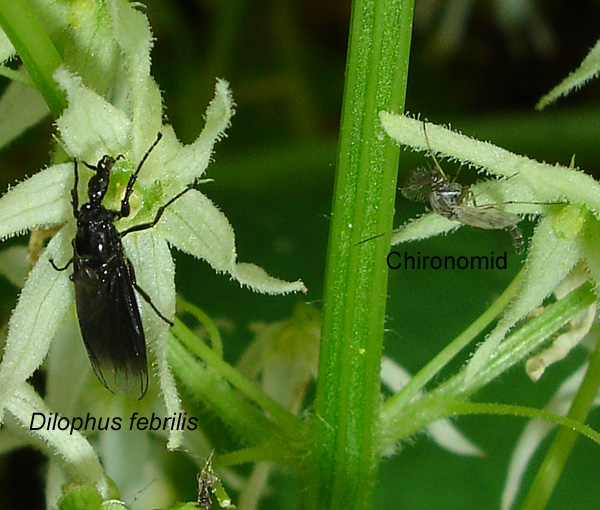 [153.72Kb] |
|
|
|
| Sundew |
Posted on 08-02-2008 22:54
|
|
Member Location: Berlin and Baden-Württemberg, Germany Posts: 3917 Joined: 28.07.07 |
PS. This is the one with the question mark of the overview photo. Probably not identifiable... But the spurs on the median tibiae are nice! Sundew Sundew attached the following image: 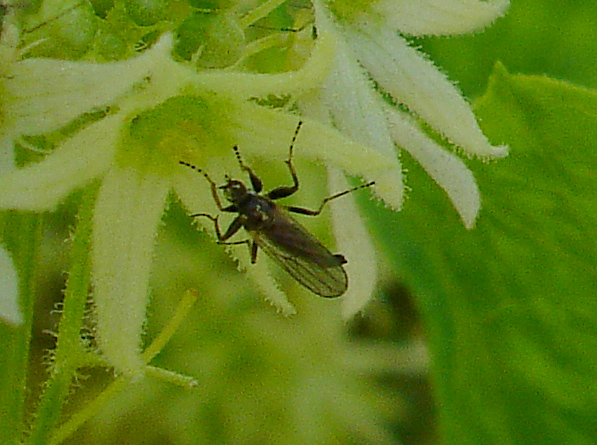 [187.48Kb] |
|
|
|
| Tony Irwin |
Posted on 09-02-2008 18:11
|
|
Member Location: Norwich, England Posts: 7286 Joined: 19.11.04 |
The last pic looks like a small Platypalpus (Hybotidae), and it's interesting to see that both male and female culicids are apparently feeding on the flowers (female mosquitoes don't just eat blood). There are indeed several chironomids present, though none have pollen on them, and most seem uninterested in the flowers - perhaps they were just resting on convenient vegetation? These Echinocystis flowers look like they have readily available nectar - the lower Dilophus picture shows this well, I think - so it may be that some of the chironomids could feed on it, but this would be unusual behaviour for them.
Tony ---------- Tony Irwin |
|
|
|
| Jump to Forum: |




